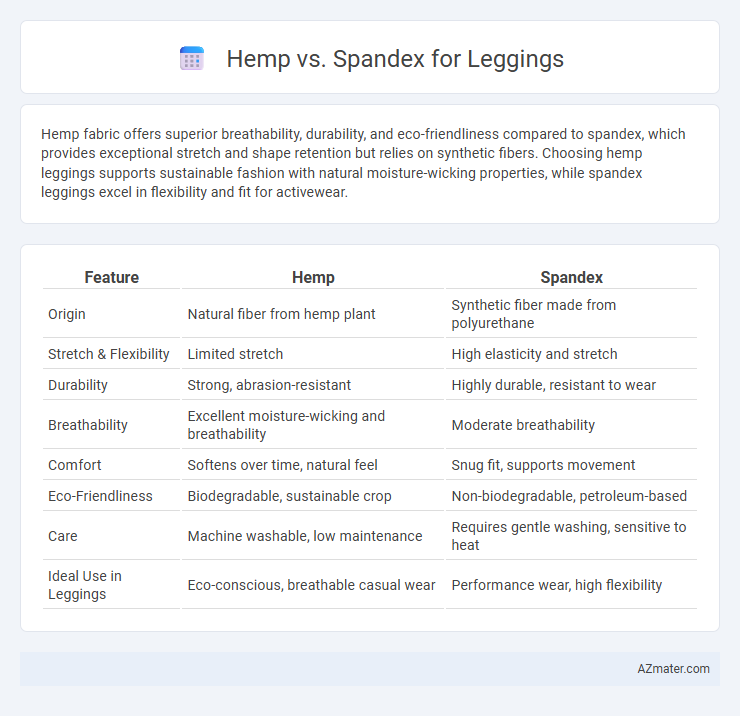Hemp fabric offers superior breathability, durability, and eco-friendliness compared to spandex, which provides exceptional stretch and shape retention but relies on synthetic fibers. Choosing hemp leggings supports sustainable fashion with natural moisture-wicking properties, while spandex leggings excel in flexibility and fit for activewear.
Table of Comparison
| Feature | Hemp | Spandex |
|---|---|---|
| Origin | Natural fiber from hemp plant | Synthetic fiber made from polyurethane |
| Stretch & Flexibility | Limited stretch | High elasticity and stretch |
| Durability | Strong, abrasion-resistant | Highly durable, resistant to wear |
| Breathability | Excellent moisture-wicking and breathability | Moderate breathability |
| Comfort | Softens over time, natural feel | Snug fit, supports movement |
| Eco-Friendliness | Biodegradable, sustainable crop | Non-biodegradable, petroleum-based |
| Care | Machine washable, low maintenance | Requires gentle washing, sensitive to heat |
| Ideal Use in Leggings | Eco-conscious, breathable casual wear | Performance wear, high flexibility |
Introduction to Hemp and Spandex Leggings
Hemp leggings are crafted from natural fibers known for durability, breathability, and eco-friendly properties, making them ideal for sustainable activewear. Spandex leggings incorporate synthetic elastane fibers, providing exceptional stretch, flexibility, and a snug fit favored in performance and athleisure apparel. Comparing hemp and spandex leggings highlights the balance between organic comfort and high-stretch functionality.
Material Origins: What are Hemp and Spandex?
Hemp is a natural fiber derived from the stalks of the Cannabis sativa plant, known for its durability, breathability, and eco-friendly cultivation process. Spandex, also called elastane, is a synthetic fiber made from polyurethane polymers, prized for its exceptional stretch and shape retention in activewear like leggings. The origins of hemp emphasize sustainability and biodegradability, while spandex offers high elasticity and resilience sourced from petrochemical processes.
Comfort and Fit Comparison
Hemp leggings offer superior breathability and natural moisture-wicking properties, making them exceptionally comfortable for prolonged wear. Spandex leggings provide exceptional stretch and elasticity, ensuring a snug fit that moves seamlessly with the body. Comparing comfort and fit, hemp delivers a soft, eco-friendly feel with moderate stretch, while spandex excels in form-fitting flexibility and durability.
Breathability and Moisture Control
Hemp fabric offers superior breathability and natural moisture-wicking properties compared to spandex, making it ideal for leggings designed to keep skin dry and comfortable during extended wear. Spandex, while highly elastic, tends to trap heat and moisture, which can lead to less effective moisture control and reduced airflow. Combining hemp with spandex blends can enhance breathability and moisture management while maintaining stretch and fit.
Durability and Longevity
Hemp fibers are known for their exceptional durability and resistance to wear, making hemp leggings highly long-lasting and ideal for frequent use. Spandex provides excellent elasticity and shape retention but tends to degrade faster over time, especially with exposure to heat and repeated stretching. Combining hemp with spandex can enhance overall garment durability by balancing hemp's toughness with spandex's flexibility.
Sustainability and Environmental Impact
Hemp leggings offer superior sustainability compared to spandex due to hemp's rapid growth cycle and minimal need for pesticides or synthetic fertilizers, reducing its environmental footprint. Spandex production relies heavily on fossil fuels and generates significant greenhouse gas emissions during the manufacturing process, leading to higher ecological impact. Biodegradable hemp fibers contribute to reduced landfill waste and soil health preservation, while spandex's synthetic nature results in persistent microplastic pollution.
Stretchability and Shape Retention
Hemp leggings offer moderate stretchability but lack the elasticity found in spandex, making them less flexible for high-performance activities. Spandex provides exceptional stretch and recovers quickly, ensuring superior shape retention even after multiple wears and washes. Combining hemp with a blend of spandex fibers enhances durability while maintaining eco-friendly benefits and long-lasting fit.
Skin Sensitivity and Allergen Concerns
Hemp leggings offer superior hypoallergenic properties and natural antimicrobial benefits, making them ideal for sensitive skin prone to irritation or allergic reactions. Spandex, while stretchy and form-fitting, is derived from synthetic materials that may cause discomfort or exacerbate skin sensitivities in some individuals. Choosing hemp fabric reduces the risk of allergic responses and promotes breathable, skin-friendly wear throughout the day.
Price Differences and Value for Money
Hemp leggings typically cost more than spandex ones due to the sustainable farming practices and durability of hemp fibers, offering long-term value through enhanced breathability and natural antimicrobial properties. Spandex leggings are generally more affordable and provide superior stretch and shape retention, making them ideal for high-performance activities at a lower upfront cost. Consumers seeking eco-friendly, durable options may find hemp leggings worth the investment despite higher prices, while budget-conscious buyers focused on elasticity and fit might prefer spandex for better value.
Final Verdict: Choosing the Right Legging Material
Hemp leggings offer superior breathability, sustainability, and natural antimicrobial properties, making them ideal for eco-conscious consumers seeking durability and comfort. Spandex leggings provide exceptional stretchability, moisture-wicking capabilities, and a snug fit, perfect for high-intensity workouts and athletic performance. Choosing the right legging material depends on prioritizing eco-friendly durability with hemp or flexibility and support with spandex for active lifestyles.

Infographic: Hemp vs Spandex for Legging
 azmater.com
azmater.com